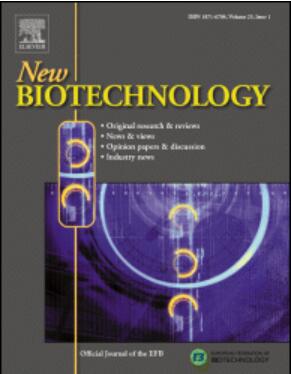Value-added utilisation of industrial by-products from bioenergy processes for growth of the PHB synthesising bacterium Cupriavidus necator
IF 4.9
2区 生物学
Q1 BIOCHEMICAL RESEARCH METHODS
引用次数: 0
Abstract
The utilisation of low-value by-products derived from the production of bioenergy as nutrient media for microbial growth was investigated using the polyhydroxybutyrate (PHB) synthesising bacterium Cupriavidus necator as a case study. The potentially suitable by-products crude glycerol (derived from biodiesel production as carbon source) and digestate (resulting from biogas production as source for nitrogen and other nutrients) contain significant amounts of nutrients but also dissolved and solid impurities. In order to minimise negative effects such as clogging in bioreactor infrastructure and complications during product recovery in a future industrial production scale, the amount of solids was reduced by filtration and centrifugation. In addition, the treatment of the liquid anaerobic digestate (LAD) included dilution and pH stabilisation in order to reduce growth inhibition due to excessive concentrations of compounds in the digestate and an unsuitable pH. Experiments were carried out in a stirred tank bioreactor comparing growth on a medium consisting only of treated LAD and crude glycerol with growth on a reference media containing crude glycerol but mineral salts instead of LAD. Fermentation with crude glycerol and LAD showed slightly reduced specific growth rates (0.1 1/h) but a similar cell dry weight (8.8 gCDW/L) compared to the reference media with crude glycerol and mineral salts (0.14 1/h and 9.5 gCDW/L). As no specific conditions were set to promote PHB accumulation, only low levels of PHA of 5,45wPHB/wCDW-% ( ± 1,5) were observed for both medium variations at the end of growth.
生物能源过程中工业副产品的增值利用对PHB合成细菌Cupriavidus necator的生长
以合成聚羟基丁酸(PHB)的Cupriavidus necator细菌为例,研究了生物能源生产中产生的低价值副产物作为微生物生长的营养培养基的利用。潜在的合适的副产品粗甘油(来自生物柴油生产作为碳源)和消化液(来自沼气生产作为氮和其他营养物质的来源)含有大量的营养物质,但也含有溶解和固体杂质。为了尽量减少负面影响,如生物反应器基础设施堵塞和未来工业生产规模中产品回收过程中的并发症,通过过滤和离心减少了固体的数量。此外,液体厌氧消化液(LAD)的处理包括稀释和pH稳定,以减少由于消化液中化合物浓度过高和pH不合适而导致的生长抑制。在搅拌槽生物反应器中进行了实验,比较了仅由处理过的LAD和粗甘油组成的培养基上的生长情况,以及在含有粗甘油但矿物盐代替LAD的参考培养基上的生长情况。与含粗甘油和无机盐的对照培养基(分别为0.14 1/h和9.5 gCDW/L)相比,含粗甘油和LAD的发酵培养基的特定生长率(0.1 1/h)略有降低,但细胞干重(8.8 gCDW/L)相似。由于没有设置促进PHB积累的特定条件,在生长结束时,两种培养基变化仅观察到低水平的5.45 wphb /wCDW-%( ± 1,5)。
本文章由计算机程序翻译,如有差异,请以英文原文为准。
求助全文
约1分钟内获得全文
求助全文
来源期刊

New biotechnology
生物-生化研究方法
CiteScore
11.40
自引率
1.90%
发文量
77
审稿时长
1 months
期刊介绍:
New Biotechnology is the official journal of the European Federation of Biotechnology (EFB) and is published bimonthly. It covers both the science of biotechnology and its surrounding political, business and financial milieu. The journal publishes peer-reviewed basic research papers, authoritative reviews, feature articles and opinions in all areas of biotechnology. It reflects the full diversity of current biotechnology science, particularly those advances in research and practice that open opportunities for exploitation of knowledge, commercially or otherwise, together with news, discussion and comment on broader issues of general interest and concern. The outlook is fully international.
The scope of the journal includes the research, industrial and commercial aspects of biotechnology, in areas such as: Healthcare and Pharmaceuticals; Food and Agriculture; Biofuels; Genetic Engineering and Molecular Biology; Genomics and Synthetic Biology; Nanotechnology; Environment and Biodiversity; Biocatalysis; Bioremediation; Process engineering.
 求助内容:
求助内容: 应助结果提醒方式:
应助结果提醒方式:


